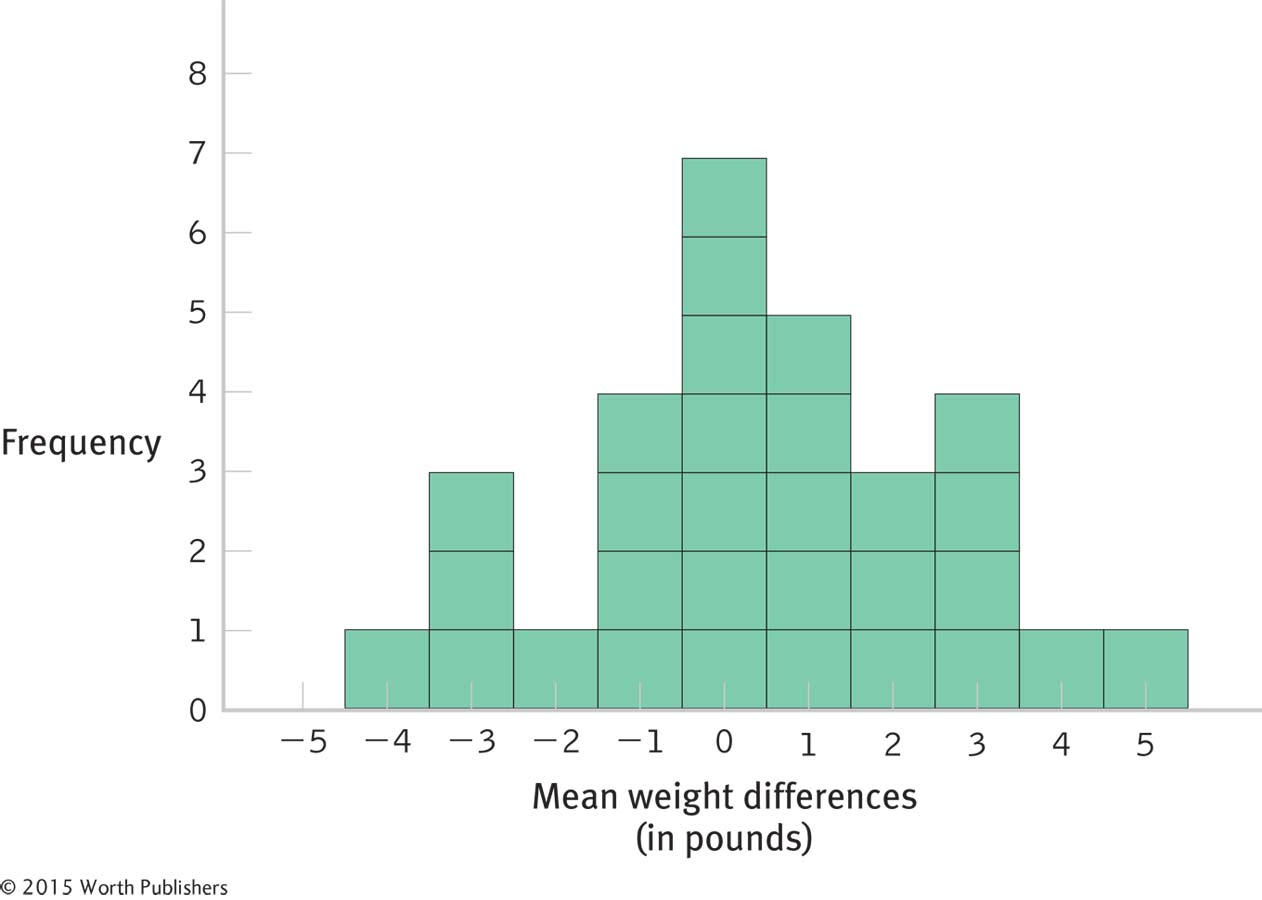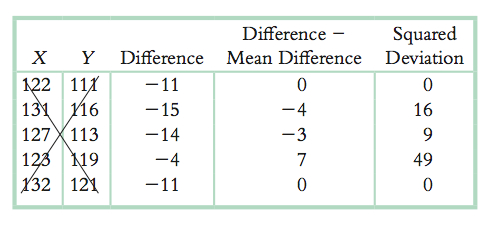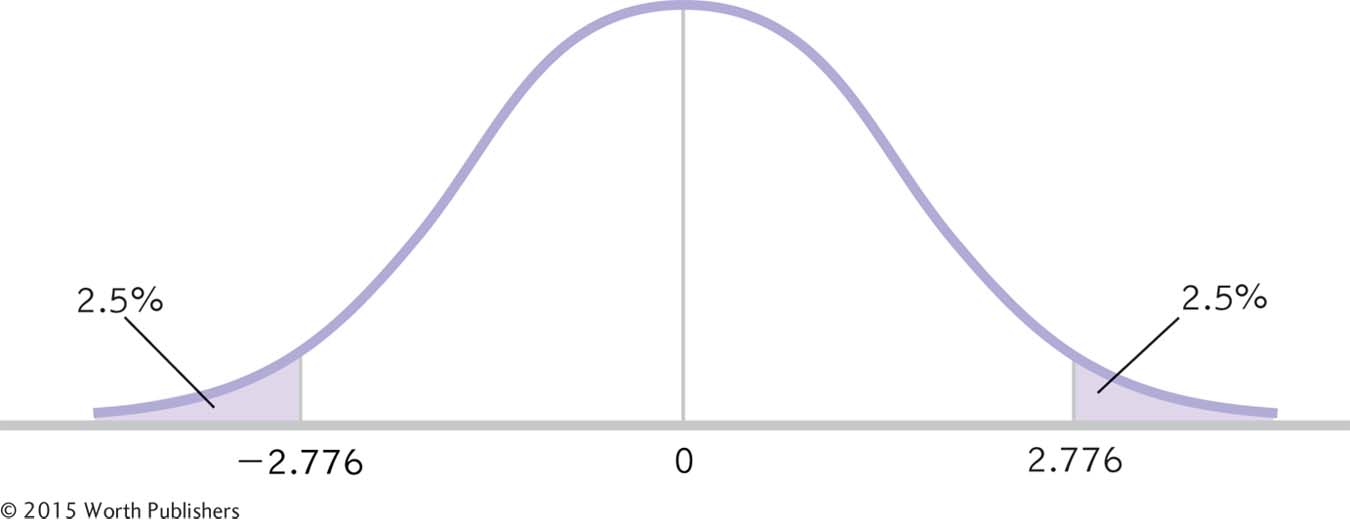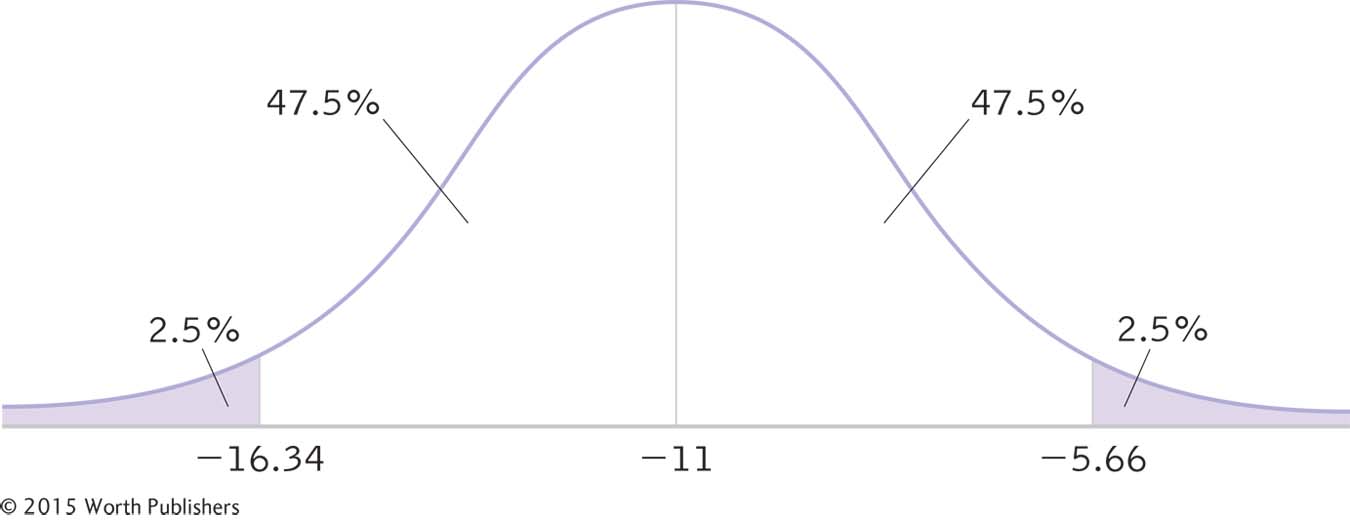9.3 The Paired-Samples t Test
As we learned in the chapter opening, researchers found that weight gain over the holidays is far less than what folk wisdom had suggested. Guess what? The dreaded “freshman 15” also appears to be a myth. One study found that male university students gained an average of 3.5 pounds between the beginning of the fall semester and November, and female students gained an average of 4.0 pounds (Holm-
The paired-
samples t test is used to compare two means for a within-groups design, a situation in which every participant is in both samples; also called a dependent- samples t test
The paired-
The steps for the paired-

Distributions of Mean Differences
We already learned about a distribution of scores and a distribution of means. Now we need to develop a distribution of mean differences for the pre-
Imagine that many college students’ weights were measured before and after the winter holidays and written on individual cards. We begin by gathering data from a sample of three people from among this population of many college students. There are two cards for each person in the population, on which weights are listed—
Step 1: Randomly choose three pairs of cards, replacing each pair of cards before randomly selecting the next.
Step 2: For each pair, calculate a difference score by subtracting the first weight from the second weight.
Step 3: Calculate the mean of the differences in weights for these three people. Then complete these three steps again. Randomly choose another three people from the population of many college students, calculate their difference scores, and calculate the mean of the three difference scores. And then complete these three steps again, and again, and again.
Let’s walk through these steps once again, using an example.
Step 1: We randomly select one pair of cards and find that the first student weighed 140 pounds before the holidays and 144 pounds after the holidays. We replace those cards and randomly select another pair; the second student had before and after scores of 126 and 124, respectively. We replace those cards and randomly select another pair; the third student had before and after scores of 168 and 168, respectively.
Step 2: For the first student, the difference between weights, subtracting the before score from the after score, is 144 − 140 = 4. She gained 4 pounds. For the second student, the difference between weights is 124 − 126 = −2. He lost 2 pounds. For the third student, the difference between weights is 168 − 168 = 0. Her weight did not change.
Step 3: The mean of these three difference scores (4, −2, 0) is 0.667. The mean change in weight is a gain of 0.667 pounds.
We would then choose three more students and calculate the mean of their difference scores. Eventually, we would have many mean differences to plot on a curve of mean differences—
But this would only be the beginning of what this distribution of mean differences would look like. If we were to calculate the whole distribution of mean differences, then we would do this an uncountable number of times. When the authors of this book calculated 30 mean differences for pairs of weights, we got the distribution in Figure 9-7. If no mean difference is found when comparing weights from before and after the holidays, as with the data we used to create Figure 9-7, the distribution would center around 0. According to the null hypothesis, we would expect no mean difference in weight—

Creating a Distribution of Mean Differences
The Six Steps of the Paired-Samples t Test
In a paired-

EXAMPLE 9.9
Let’s use an example from the software industry (which employs social scientists to improve the ways in which people interact with their products). For example, behavioral scientists at Microsoft studied how 15 volunteers performed on a set of tasks under two conditions—
Here are five participants’ fictional data, which reflect the actual means reported by the researchers. Note that a smaller number is good—
STEP 1: Identify the populations, distribution, and assumptions.
MASTERING THE CONCEPT
9-
The paired-
Summary: Population 1: People performing tasks using a 15-
The comparison distribution is a distribution of mean difference scores based on the null hypothesis. The hypothesis test is a paired-
This study meets one of the three assumptions and may meet the other two: (1) The dependent variable is time, which is scale. (2) The participants were not randomly selected, however, so we must be cautious with respect to generalizing the findings. (3) We do not know whether the population is normally distributed, and there are not at least 30 participants. However, the data from this sample do not suggest a skewed distribution.
STEP 2: State the null and research hypotheses.
This step is identical to that for the single-
Summary: Null hypothesis: People who use a 15-
STEP 3: Determine the characteristics of the comparison distribution.
This step is similar to that for the single-
For the paired-
Summary: µM = 0; sM = 1.924
Calculations: (Notice that we crossed out the original scores once we created the column of difference scores. We did this to remind ourselves that all remaining calculations involve the differences scores, not the original scores.)

The mean of the difference scores is:
Mdifference = −11
The numerator is the sum of squares, SS (which we learned about in Chapter 4):
SS = 0 + 16 + 9 + 49 + 0 = 74
The standard deviation, s, is:

The standard error, sM, is:

STEP 4: Determine the critical values, or cutoffs.
This step is the same as that for the single-
Summary: df = N − 1 = 5 − 1 = 4
The critical values, based on a two-

Determining Cutoffs for a Paired-
STEP 5: Calculate the test statistic.
This step is identical to that for the single-
Summary: 
STEP 6: Make a decision.
This step is identical to that for the single-
Summary: Reject the null hypothesis. When we examine the means (MX = 127; MY = 116), it appears that, on average, people perform faster when using a 42-

Making a Decision
The statistics, as reported in a journal article, follow the same APA format as for a single-
t(4) = −5.72, p < 0.05
We also include the means and the standard deviations for the two samples. We calculated the means in step 6 of hypothesis testing, but we would also have to calculate the standard deviations for the two samples to report them.
The researchers note that the faster time with the large display might not seem much faster but that, in their research, they have had great difficulty identifying any factors that lead to faster times (Czerwinski et al., 2003). Based on their previous research, therefore, this is an impressive difference.
Calculating a Confidence Interval for a Paired-Samples t Test
MASTERING THE CONCEPT
9-
The APA encourages the use of confidence intervals and effect sizes (as with the z test and the single-
EXAMPLE 9.10
Let’s start by determining the confidence interval for the productivity example. First, let’s recap the information we need. The population mean difference according to the null hypothesis was 0, and we used the sample to estimate the population standard deviation to be 4.301 and the standard error to be 1.924. The five participants in the study sample had a mean difference of −11. We will calculate the 95% confidence interval around the sample mean difference of −11.
STEP 1: Draw a picture of a t distribution that includes the confidence interval.
We draw a normal curve (Figure 9-10) that has the sample mean difference, −11, at its center instead of the population mean difference, 0.

A 95% Confidence Interval for a Paired-
STEP 2: Indicate the bounds of the confidence interval on the drawing.
As before, 47.5% fall on each side of the mean between the mean and the cutoff, and 2.5% fall in each tail.
STEP 3: Add the critical t statistics to the curve.
For a two-

A 95% Confidence Interval for a Paired-
STEP 4: Convert the critical t statistics back into raw mean differences.
As we do with other confidence intervals, we use the sample mean difference (−11) in the calculations and the standard error (1.924) as the measure of spread. We use the same formulas as for the single-

A 95% Confidence Interval for a Paired-
Mlower = −t(sM) + Msample = −2.776(1.924) + (−11) =−16.34
Mupper = t(sM) + Msample = 2.776(1.924) + (−11) =−5.66
The 95% confidence interval, reported in brackets as is typical, is [−16.34, −5.66].
STEP 5: Verify that the confidence interval makes sense.
MASTERING THE FORMULA
9-
The sample mean difference should fall exactly in the middle of the two ends of the interval.
−11 − (−16.34) = 5.34 and −11 − (−5.66) = −5.34
We have a match. The confidence interval ranges from 5.34 below the sample mean difference to 5.34 above the sample mean difference. If we were to sample five people from the same population over and over, the 95% confidence interval would include the population mean 95% of the time. Note that the population mean difference according to the null hypothesis, 0, does not fall within this interval. This means it is not plausible that the difference between those using the 15-
As with other hypothesis tests, the conclusions from both the paired-
Calculating Effect Size for a Paired-Samples t Test
As with a z test, we can calculate the effect size (Cohen’s d) for a paired-
EXAMPLE 9.11
MASTERING THE FORMULA
9-

It is the same formula as for the single-
Let’s calculate the effect size for the computer monitor study. Again, we simply use the formula for the t statistic, substituting s for sM (and μ for μM, even though these means are always the same). This means we use 4.301 instead of 1.924 in the denominator. Cohen’s d is now based on the spread of the distribution of individual differences between scores, rather than the distribution of mean differences.

The effect size, d = −2.56, tells us that the sample mean difference and the population mean difference are 2.56 standard deviations apart. This is a large effect. Recall that the sign has no effect on the size of an effect: −2.56 and 2.56 are equivalent effect sizes. We can add the effect size when we report the statistics as follows: t(4) = −5.72, p < 0.05, d = −2.56.
CHECK YOUR LEARNING
| Reviewing the Concepts |
|
|||||||||||||
| Clarifying the Concepts | 9- |
How do we conduct a paired- |
||||||||||||
| 9- |
Explain what an individual difference score is, as it is used in a paired- |
|||||||||||||
| 9- |
How does creating a confidence interval for a paired- |
|||||||||||||
| 9- |
How do we calculate Cohen’s d for a paired- |
|||||||||||||
| Calculating the Statistics | 9- |
Below are energy-
|
||||||||||||
| 9- |
Assume that researchers asked five participants to rate their mood on a scale from 1 to 7 (1 being lowest, 7 being highest) before and after watching a funny video clip. The researchers reported that the average difference between the “before” mood score and the “after” mood score was M = 1.0, s = 1.225. They calculated a paired-
|
|||||||||||||
| Applying the Concepts | 9- |
Using the energy- |
||||||||||||
| 9- |
Using the energy-
|
Solutions to these Check Your Learning questions can be found in Appendix D.